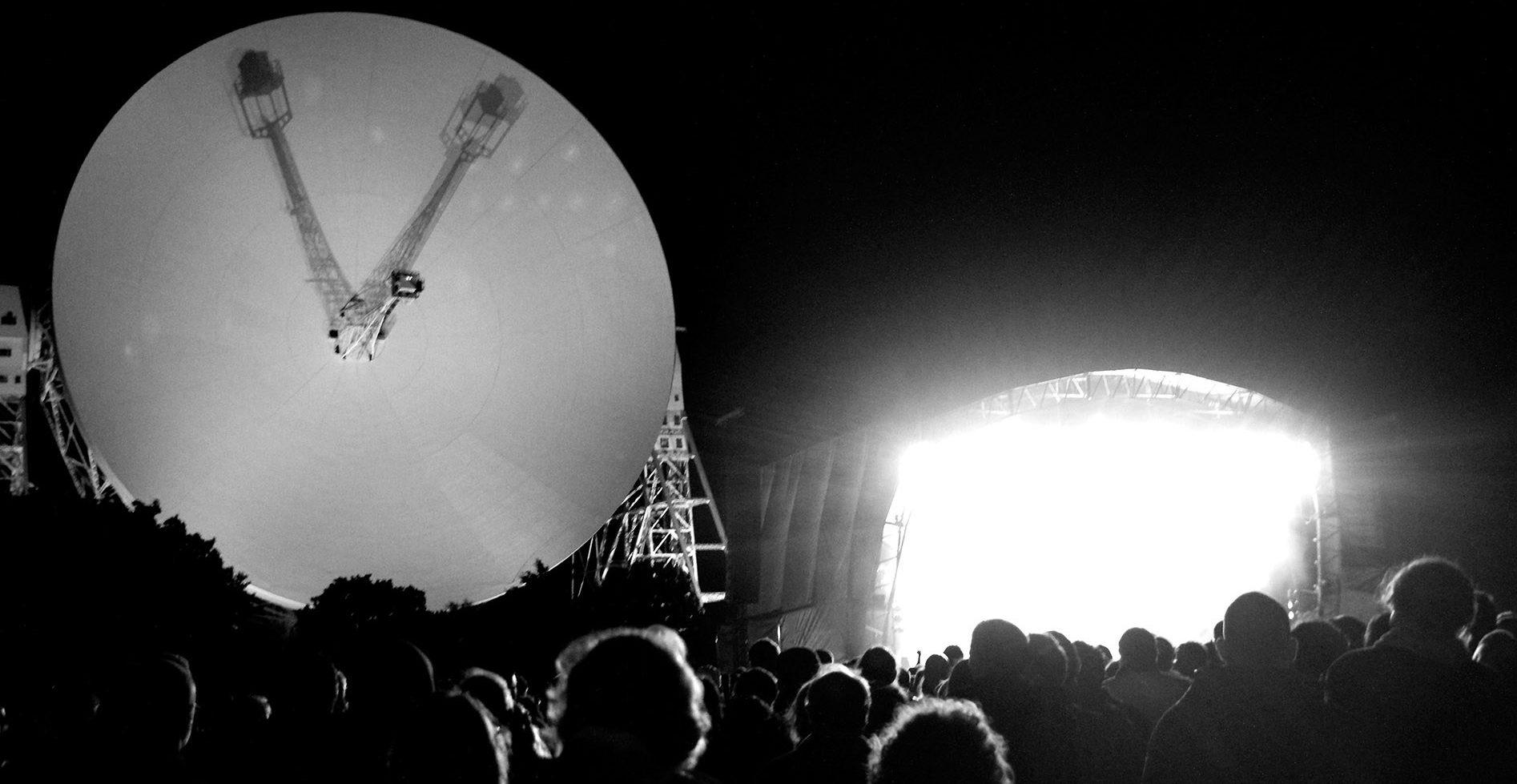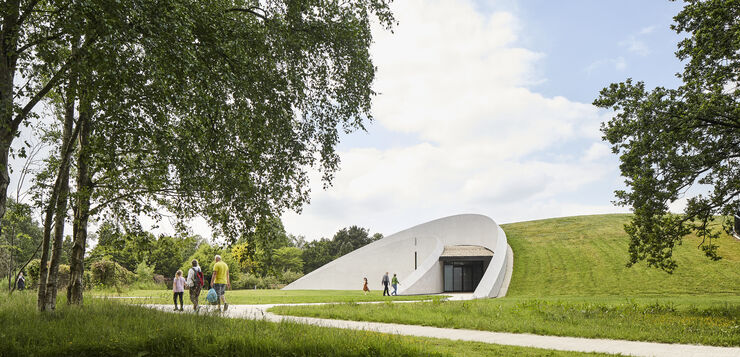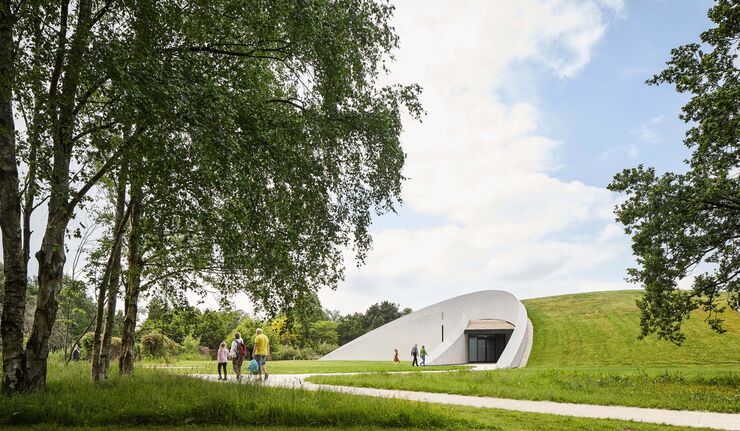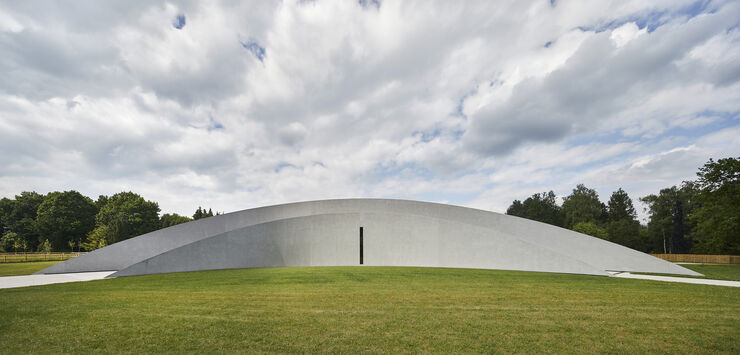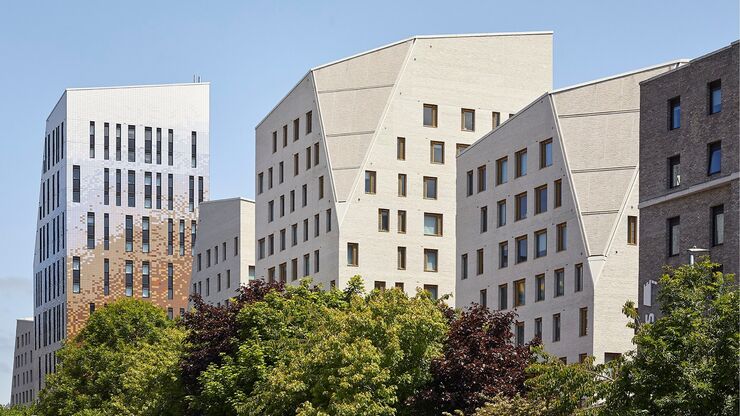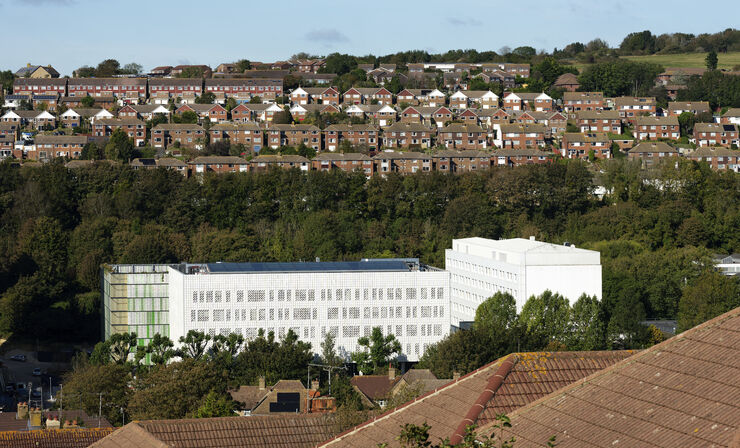Transcript
Julian Gitsham:
From Hassell, an award-winning, multi-disciplinary global design practise. This is Hassell Talks.
Hello, I’m Julian Gitsham. I’m an architect and I work in our London Studio. Universities are so exciting because they epitomise the state of flux the students are in and the process of change during their time studying and experiencing life and learning in their chosen city or campus. They also very often launch people into their chosen fields and create a pathway for a role in the future. I often think it’s a privilege to be able to design educational spaces and to be able to work with great academic minds, enthusiastic and committed students, and to help shape the problem solvers of the future.
If you haven’t stepped foot into a university campus in a while, you won’t realise the enormous shifts going on inside educational institutions around the world. Long before COVID, there was a sense from our university clients and education collaborators that we were talking to that greater change was needed to reflect the extraordinary times that we’re living through, to help solve the biggest challenges the world is currently facing, and to change the preconceptions of what university campus is, and could be, designing for a completely new generation of thinkers.
In the real world, everything is mingled together. Problems and challenges aren’t definable to one issue or source. And so, how do we take these sometimes very established institutions and use design to help them? I’d like to explore today interdisciplinary approaches to education with benefits of designing environments around problem-solving rather than disciplines, and the challenges to, and role of equality inclusion in areas like science, technology, engineering, and mathematics, and how good design can create and facilitate inclusive, innovative, and problem-solving campuses.
I have with me two guests who have, over the years, never failed to inspire me as innovators and communicators of exactly this, of crossing the thresholds of thinking and thinking big. I’m delighted to welcome Teresa Anderson and Tim O’Brien to the conversation. If those names sound familiar, it’s because Teresa and Tim are the team behind the music, science and culture event, the Bluedot Festival. Bluedot takes place at Jodrell Bank Observatory and Discovery Centre in Cheshire, England and attracts headline acts like Bjork, Underworld, [inaudible 00:02:27], the Flaming Lips, Chemical Brothers, and Kraftwerk.
Teresa Anderson MBE is a British physicist and the director of the University of Manchester’s Discovery Centre at Jodrell Bank. She has a PhD in Electrical Engineering and a Master’s in fine art. She’s a professor at the University of Manchester and has until recently been the chair of the Daphne Jackson Trust, which provides fellowships to scientists, technologists, engineers, and mathematicians to return them to their careers after a career break of over two years taken for family, caring, or health reasons.
Tim O’Brien is an astrophysicist and a professor at the University of Manchester’s School of Physics and Astronomy. He is Associate Director of Bank Centre for Astrophysics and I’m delighted that they are able to join me.
Welcome.
Professor Teresa Anderson:
I should probably just declare an interest at this point because Tim and I are married to each other, which we haven’t yet said. We’re a husband and wife team and we do quite a lot of weird and wacky things together, like, for example, weird events at Jodrell Bank, and making Jodrell Bank a world heritage site and things. One of the things we-
Professor Tim O’Brien:
Yeah, small things like that.
Professor Teresa Anderson:
Yeah, little things like that. One of the things that we are very interested in, and it’s because we’ve both got science backgrounds, massive science backgrounds, is the fact that as far as we’re concerned, science is part of culture, but people who are kind of more steeped in the culture side of things don’t seem to see science like that, so you end up… I blame C.P. Snow with his flipping two cultures thing for a lot of this because a lot of people who don’t have a science background think that science is something different, when as far as we are concerned, it’s a realm of human endeavour. It takes creativity, a lot of grit, a lot of patience, diligence, discipline, all of those things that everything takes if you’re going to be good at it. We wanted to express that and explore that with as many people as possible and people who are interested in culture, props a bit, I don’t know if it’s intimidated by science, but can’t find a root in, so we wanted to just take down the barriers a bit and have a bit of fun, obviously, because it is fun.
Professor Tim O’Brien:
Come and have some fun and sort of learn something, as well.
Professor Teresa Anderson:
Yeah.
Julian Gitsham:
Nice. It is fun. It is fun. I loved your quote about strange beasts. It being a strange beast and that combination of culture, and music, and science.
Professor Teresa Anderson:
Still, people don’t get it. People still say, “Well, is it an arts festival, or is it a science festival, or is it a music festival?” Well, it’s everything. It’s a mix of everything and it still defies categorization.
Professor Tim O’Brien:
I think it’s a festival of creativity really, in a sense. We talk about the creative sector and generally, that’s some sort of shorthand for often sort of arts, and culture, and like we were saying, TV and film and all these sorts of things. And of course, they’re incredibly important, but it somehow seems to almost exclude the science and engineering side of things, which are equally creative in their own way. You couldn’t do scientific research without being creative. You’re creating new knowledge.
Actually, our sort of view is that it’s not the case that one of these things is more important than the other. They work together, actually. You couldn’t have bands like, I don’t know, Kraftwerk or something like that, which are completely reliant on synthesisers and were pioneers in electronic music. Of course that’s completely based on engineering and the scientific understanding of how music works. I think that’s how we’re feeling is just to get people together in a space, whether they’re artists, musicians, scientists, engineers, whatever, and just share our sort of view… As Teresa [inaudible 00:06:39] what we’re doing really and our joy of understanding the planet and our place in the universe.
Professor Teresa Anderson:
The other thing that’s quite interesting is that we mix people up. I mean, when we had Kraftwerk for example, we had an event after the Kraftwerk performance when Tim, in collaboration with them, and with their permission and they were in the room… And I say room, it was like 2000 people in a big tent. Tim bounced their music off the surface of the moon. Now is that science? Yes. Is it technology? Yes. Is it art? Yes. Is it music? Yes. Was it a big collective experience? Yes. Did we all cheer? “Yes!” When it came back? It was just a fantastic moment and that’s kind of what we’re about, those sort of moments of crossover, and connection, and celebration.
Julian Gitsham:
Yes. I think that’s why I was so particularly interested in it in terms of the learning environment and how we translate that into the next generation of thinkers. So Bluedot has obviously got a huge range of people coming to it, and you also have a huge range of people coming to the Discovery Centre, starting with the very young, primary or preschool age. And I think I’m sort of interested in… You said something, Teresa, earlier about how some people still don’t get it, how they want to categorise it. And that’s the brilliant thing about it is you can’t.
Just sort of thinking a bit more than about the students that you both are working with, and so those on campus at Manchester University and those coming and researching, and those professionals and academics working at Jodrell Bank, what do you think that we could bring to those environments to make them work even better? Because a lot of the work that we’re now trying to do when designing spaces for research is to not have categorization, to make sure that it’s as interdisciplinary as possible, basically. So you’re not having any silos. And I’m wondering what we can bring to that thinking that we might be able to learn from these experiences that you’ve had.
Professor Tim O’Brien:
In a way, you need all these things. You need silos and you need interdisciplinary. I don’t think you can get out, because to make progress in a particular field, you do need to immerse yourself in that field and you need to surround yourself with people who are also working in that field and are experts in that field. You’re not going to make progress if you only talk to people from outside of your field. But equally, if you are only to talk to people inside your field, you’re going to miss out on different ways of doing things, different approaches, different questions. It’s quite a difficult answer, isn’t it? Because you are right, interdisciplinary is important, but we shouldn’t forget that people need quiet spaces, they need spaces to be with themselves and with their thoughts, as well as with other people. But then having some spaces where you intersect, where you clearly can work with the people who are the experts in the exact thing you’re working on.
I mean we’re doing a course at the moment-
Julian Gitsham:
Yes.
Professor Tim O’Brien:
… for undergraduates at Manchester. We’ve got an area of the university called the University College of Interdisciplinary Learning, UCIL, UCIL. And its aim is actually to put on courses that are open to students from across the university. So students are given an experience of a subject outside of their primary field of study. And so we’re, myself, Mike Garrett, who’s in Jodrell as well, a biologist and a person working in culture and the media, have developed a course on aliens, basically. So alien life, extraterrestrial life. And it’s interdisciplinary from the outset because that idea that we use our radio telescopes to search for extraterrestrial signals, we do. Just in case extraterrestrials are sending us messages, it would be remiss of us not to be looking. So we do do that and we haven’t found any yet.
I can’t announce that on your podcast, I’m afraid.
Julian Gitsham:
That [inaudible 00:11:24] real, wasn’t it?
Professor Tim O’Brien:
Just letting you know straight off, you’re not getting an exclusive, but we haven’t yet found any. We could, right? There could easily be extraterrestrials out there. So there’s a whole area of science that has physics, and astrophysics, and it has technical engineering aspects to it, searching for extraterrestrials. It then spills over into biology. What is life anyway? What sort of extraterrestrial life might exist? What’s the requirements for life? But then it has this whole cultural dimension, how do we feel about… What do we mean by aliens, extraterrestrials? How are they represented in literature, in film, and so on? And so that course is very interesting for us. We get students from across the university taking it, and it’s all online, and it’s been very popular and I think we’ve really enjoyed teaching it and hearing from people with these different perspectives.
Julian Gitsham:
But I think with the first light project, that place, everybody that I’ve spoken to and my own experience of it as well, is that people will hopefully turn up and go, “Good grief. Wow, this is amazing. What a place, I never thought this was here.” Hopefully, was that your vision for the project and is that kind of in the context of this sort of learning experience?
Professor Teresa Anderson:
Yeah, I think we both decided that’s what we wanted. And it’s a challenge at Jodrell because at Jodrell, we have the Lovell telescope, the grade one listed amazing, massive icon of science. And to create something people, get off a couch or out of a car and go, “Wow,” and see it from the hills, and what have you. And so to have something else, another structure at the site, that doesn’t compete with the Lovell, that actually is in the same vein, it’s about humanity’s relationship with the sky is amazing. And every person I’ve taken to show them around so far has said, “Wow.” They’ve said, “Wow.” Every single person has walked up-
Julian Gitsham:
Fantastic.
Professor Teresa Anderson:
… the little approach that we’ve got between the two hedges. There’s a little bit of a reveal, let’s face it, at the end, and everybody’s gone-
Julian Gitsham:
Yes.
Professor Teresa Anderson:
…“Wow, that’s amazing.” And then when they get inside, there’s another “Wow” because of that amazing window, that’s the meridian line, that’s the internal sundial within the building.
Those structure like Newgrange. And it’s in that tradition. And in fact, it’s really funny, we had a meeting of the World Heritage site steering group, and people came from UNESCO and what have you, and we took them to see it and they all went, “Wow.” And then because they know about the Heritage, one of them said, “Oh my God, it’s like Newgrange.” And they suddenly came out with all these archaeological, historical, millennia old references to these structures that connect to the sky. And that’s what Tim and I really thought at the start when we were writing the funding bids, writing the spare, everything. That’s what we’d asked for. So yeah, we’re delighted with it. Yeah.
Julian Gitsham:
Isn’t it a brilliant example of that combination of culture and history and science together? All working together and just creating that experience? So I suppose that there’s… It’s interesting, isn’t it that the whole Jodrell Bank place and site, and World Heritage site? Do you bring students, undergraduates, post grads, early career researchers, et cetera, to the site as often? I mean, I’m sure they… Do they study much on…?
Professor Tim O’Brien:
Yeah, undergraduates come out in the first week when they arrive at university. They have a special sort of visit to see the place, basically. So there’s buses that bring people out to have a tour around. But then of course they actually use it as part of their studies. So there’s both, as they go through in a degree in physics, they use the telescopes at Jodrell remotely, initially. So over a viral web interface, they can use one of our telescopes here and then we bring them out to use the telescopes personally. So they come and visit later in their degree. And then of course the researchers use it all the time. So you don’t have to be at a telescope to use it. I mean, I use telescopes on spacecraft and rather sadly I don’t get to go to the spacecraft to use them.
So we actually make a special point for the research group that makes most use of the Lovell telescope, which is the Pulsar group. They actually come out to Jodrell once a week, specially. And the only reason for doing that, in fact, was so that they could see the telescope that takes the data with which they were working. Otherwise, we could have just left them in Manchester on campus and they could have downloaded the data and gone on with it. But we felt it was important for them to have that connection. And it is an emotional connection as well with the telescope.
Professor Teresa Anderson:
We also have Master students coming in from schools of arts languages and cultures now. So Master’s students in cultural practise come and do internships with us. And since we’ve created this centre, and Bluedot, and what have you, and also the World Heritage site, so we now are being interdisciplinary in our contribution to the post-grad research and practise that’s going on. So it’s definitely growing, I think.
Julian Gitsham:
It’s really interesting. Now, do you think that there’s a place for bringing that idea, that concept, to the campus? So almost the reverse of art. I mean, you talked to [inaudible 00:17:43] also in the past about wow moments and that inspiration that you need, and I wondered what you meant by that when you spoke about that? Was that about-
Professor Teresa Anderson:
Yeah, so-
Julian Gitsham:
… an experience, or an emotion, or a place?
Professor Teresa Anderson:
I think it’s about emotion because I think the thing is now more than ever, information’s available everywhere and you’re not really… Education isn’t really about delivering information, it’s about developing skills. And it is partly about imparting what’s understood in your field, but the thing is that people are only going to learn and engage with whatever they’re interested in. If they care about it, if they have a “Wow that’s amazing,” or “Oh, that’s funny,” or, “I’m really curious about that.” This sort of emotional moment starts the movement towards investigation and what have you. And we always say if you can get a kid to say, “Well, why is the sky blue?” The minute they ask that question, that makes them a scientist, effectively. That’s what science is about. It’s about being curious and taking responsibility for your own exploration of it. But people only do that if they care.
Julian Gitsham:
Yes.
Professor Teresa Anderson:
And they only care if it’s exciting, or it’s intriguing, or annoying, or whatever. And those are all emotions.
Julian Gitsham:
Yes.
Professor Teresa Anderson:
It’s about engaging people as a whole person, not just a brain.
Julian Gitsham:
We’ve been doing a lot of work in Martin University master planning where we’re trying to bring interventions and relationships between culture, perhaps in the city. You’re bringing a programme of events aligned with the universities together so that you are creating the festivals there and emotional experiences there rather than just a bunch of buildings. And I wondered what you thought about whether you could reverse that, the idea of Bluedot, but in a more campus based experience?
Professor Teresa Anderson:
I think it’s got to have… One of the things about Jodrell, though is its sense of place. And the fact that the site is dominated by a huge, massive radio telescope, which is a very weird thing, just creates a certain experience. And I mean we do do-
Julian Gitsham:
Yes.
Professor Teresa Anderson:
… Bluedot, micro dots as we call them, in urban environments. And they have a different character. And the university actually has lots of other little festivals around. There’s a sustainability one and there’s various other things that I think one of the things that you have to remember is there’s a sort of authenticity, really, that is to do with a sense of place. And getting that tone is quite an interesting challenge.
Professor Tim O’Brien:
I mean, it just depends-
Julian Gitsham:
Yes.
Professor Tim O’Brien:
… on your, like Teresa says, I think having something like Jodrell has its own particular impact because of the location, because it’s very tied into that location and the giant telescope that’s looking out into space while people are there. I think that’s what people love about that. But equally, you could have an event in the city and then you get a different group of people coming along. So yeah, the university has a community festival where it’s in one of the university buildings and local residents can come in and find out what’s going on in those buildings. We set up a science engagement event, it’s called “ScienceX” a few years ago. That’s been very successful. And it’s in the traffic centre, the big shopping centre in Manchester, or just out in Trafford Park, just-
Professor Teresa Anderson:
It was Tim’s idea, actually.
Professor Tim O’Brien:
Yeah.
Julian Gitsham:
You like your traffic centres, do you, Tim?
Professor Tim O’Brien:
It’s a bit [inaudible 00:21:42]. I know faculty, for the science and engineering faculty, and we get a whole bunch of researchers and undergraduate, postgraduate students, researchers, and they go into the shopping centre and they set up stalls within the shopping centre and we basically capture people that are doing the shopping. And they’re walking past and they see this stand with a… I don’t know, might have a Formula One car on it or something like that if the engineering students are there, or a flight simulator, or a virtual reality headset showing them the universe, which is what we’ve taken along. And then they basically come along and they have a goal and they get to have a chat to some of the researchers. But that’s an intervention where you interact with people that weren’t expecting you to be there. They didn’t have to make an effort to go to your event, you go to them.
And that’s another way of doing these things that I think is quite important. And I think universities, and picking up your point about what to do in universities and university buildings, it’s like having buildings that are themselves… We talked about the First Light Pavilion, the new building at Jodrell, and how wonderful it is, and how amazing it looks even from the outside. And then from the inside it’s a different experience again. And that I think that should carry across into as many university buildings as you can, on campus as well, because that excitement of seeing the structure and then being able to go inside and find out what’s going on in there is I think really, really crucial, actually. And you do see there are nice buildings and there are less nice buildings.
Julian Gitsham:
And sometimes you don’t need a building at all, actually, to create that sort of sense of place. One of the interesting projects we’ve just finished is at Brighton University, a new academic building at the business school. But the idea behind it was to make it a part of Brighton. So that sense of place that you were talking about was really important for community involvement and connection. So we took the idea of the character of Brighton being artistic, and a bit punky, and a bit anarchic, and Brighton Pier and that sense of fun and activity. And then in the idea of the murmurations, the starlings over Brighton Pier, which I’m sure you’re very familiar with, as scientists, about the state of flux. And we tried to interpret that in the façade so that the façade represented this sense of change using different tile types and finishes and reflectivity, whereas the lower levels was all about the sense of fun and activity at Brighton Pier. So it was quite an interesting project.
Professor Teresa Anderson:
But you can never tell how people are going to react to something and how they’re going to then create their own experience and-
Julian Gitsham:
Yes.
Professor Teresa Anderson:
… engagement with the space. And so it’s always a little bit of… I think one of the things I say often said is we have to create spaces where these moments can happen, but you can’t make them happen. You’ve got to sort of try and put all the ingredients there and then people create their own encounters. And one of the things I really love, kind of walking around Bluedot, not quite with a paper bag over my head, but people don’t recognise me as much as they recognise Tim because I haven’t been on telly. But I love walking about and then you see families or people just encountering experiments, or somebody’s making rockets out of pop bottles, or you see one of your colleagues who in normal times is standing there giving a lecture, being questioned quite assiduously by a group of kids with sparkly hair or something and you just think, “Oh, that’s really nice.” So that you have that sense of, well, you’ve facilitated people creating their own moments. Yeah, it’s quite a privilege to be able to see it happening.
Julian Gitsham:
It’s amazing.
I remember coming as a boy to Jodrell Bank, my hometown’s not far away, and getting a little ticker tape souvenir.
Professor Teresa Anderson:
Everybody mentions that, Julian, everybody mentions that. The ticker tape.
Julian Gitsham:
Isn’t it amazing, the ticker tape?
Professor Teresa Anderson:
Yeah.
Julian Gitsham:
That experience is still there, isn’t it? It’s been really, really interesting. Thank you very much both of you for those insights and for those stories. It’s a delight for me to have worked on those projects with you both and it’s been a privilege to get about learning as well. And I’m hoping, Tim, that you might just reveal about the aliens right at the last points, but come in now if you wish to say anything, otherwise all for me to say thank you very, very much indeed. It’s been lovely to talk and thank you all for listening. You’ve been listening to… I feel like I’m on Radio Four. You’ve been listening to Hassell Talks with me, Julian Gitsham, and please do keep an eye out for more episodes coming soon. We’ve had some terrific reviews being left for the podcast, so thank you to our listeners for those. And just finally subscribing and leaving us a review or rating helps us get out there, and shares the fantastic insights that we’ve heard today that we are gathering from across our network of designers, researchers, and strategists.
So don’t forget, you can find more about our work and insights at hassellstudio.com. This episode was produced by Prue Vincent and Annie Scapetis, with thanks to One Fine Play. Thank you and goodnight.
